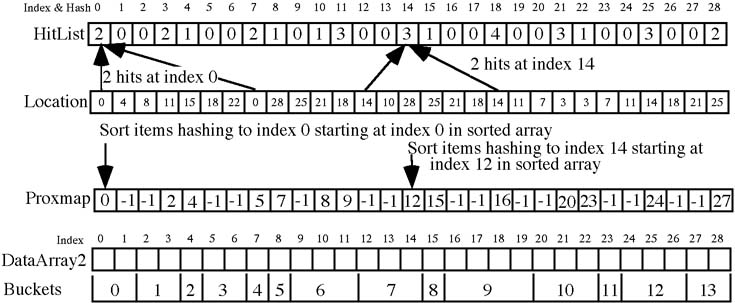ProxMap Sorting uses a different approach to sorting, which conceptually is similar to
hashing. This technique uses a variation on hashing with buckets, but with buckets of
different sizes.
Sample Code:
/***************************************/
/* ProxmapSort() */
/* */
/* Sort records on integer key using */
/* a proxmap sort. */
/***************************************/
void ProxmapSort(StructType DataArray[], StructType DataArray2[],int count)
{
int i;
int HitList[ARRAYSIZE];
int Hidx; /* Hashed index */
int ProxMap[ARRAYSIZE];
int RunningTotal; /* Number of hits */
int Location[ARRAYSIZE];
int KeyMax, KeyMin; /* Used in Hash() */
/* Initialize hit list and proxmap */
for(i=0; i<count; i++)
{
HitList[i] = 0; /* Init to all 0 hits */
ProxMap[i] = -1; /* Init to all unused */
DataArray2[i].key = -1; /* Init to all empty */
}
/* Find the largest key for use in computing the hash */
KeyMax = 0; /* Guaranteed to be less than the smallest key */
KeyMin = 32767; /* Guaranteed to be more than the largest key */
for(i=0; i<count; i++)
{
if(DataArray[i].key > KeyMax) KeyMax = DataArray[i].key;
if(DataArray[i].key < KeyMin) KeyMin = DataArray[i].key;
}
/* Compute the hit count list (note this is not a collision count, but
a collision count+1 */
for(i=0; i<count; i++)
{
Hidx = Hash(DataArray[i].key, KeyMax, KeyMin, count); /* Calculate hash index */
Location[i] = Hidx; /* Save this for later. (Step 1) */
HitList[Hidx]++; /* Update the hit count (Step 2) */
}
/* Create the proxmap from the hit list. (Step 3) */
RunningTotal = 0; /* Init counter */
for(i=0; i<count; i++)
{
if(HitList[i] > 0) /* There were hits at this address */
{
ProxMap[i] = RunningTotal; /* Set start index for this set */
RunningTotal += HitList[i];
}
}
// NOTE: UNCOMMENT THE FOLLOWING SECTION TO SEE WHAT IS IN THE ARRAYS, BUT
// COMMENT IT OUT WHEN DOING A TEST RUN AS PRINTING IS VERY SLOW AND
// WILL RESULT IN AN INACCURATE TIME FOR PROXMAP SORT.
/* ----------------------------------------------------
// Print HitList[] to see what it looks like
printf("HitList:\n");
for(i=0; i<count; i++)
printf("%d ", HitList[i]);
printf("\n\n");
getch();
// Print ProxMap[] to see what it looks like
printf("ProxMap:\n");
for(i=0; i<count; i++)
printf("%d ", ProxMap[i]);
printf("\n\n");
getch();
// Print Location[] to see what it looks like
printf("Location:\n");
for(i=0; i<count; i++)
printf("%d ", Location[i]);
printf("\n\n");
getch();
--------------------------------------------- */
/* Move the keys from A1 to A2 */
/* Assumes A2 has been initialized to all empty slots (key = -1)*/
for(i=0; i<count; i++)
{
if((DataArray2[ProxMap[Location[i]]].key == -1)) /* If the location in A2 is empty...*/
{
/* Move the structure into the sorted array */
DataArray2[ProxMap[Location[i]]] = DataArray[i];
}
else /* Insert the structure using an insertion sort */
{
ProxMapInsertionSort(DataArray2, &DataArray[i], ProxMap[Location[i]], HitList[Location[i]]);
}
}
}
/***************************************/
/* Hash() */
/* */
/* Calculate a hash index. */
/***************************************/
int Hash(int key, int KeyMax, int KeyMin, int count)
{
float keyFloat; /* Map integer key to float in the range 0 <= key < 1 */
keyFloat = (float)(key - KeyMin) / (float)(1 + KeyMax - KeyMin);
/* Map float key to indices in range 0 <= index < count */
return((int)floor(count * keyFloat));
}
/***************************************/
/* ProxMapInsertionSort() */
/* */
/* Use insertion sort to insert a */
/* struct into a subarray. */
/***************************************/
void ProxMapInsertionSort(StructType DataArray[], StructType *theStruct,
int startIdx, int listLen)
{
/* Args: DataArray - Partly sorted array
*theStruct - Structure to insert
startIdx - Index of start of subarray
listLen - Number of items in the subarray */
int i; /* Find the end of the subarray */
i = startIdx + listLen - 1;
while(DataArray[i-1].key == -1) i--; /* Find the location to insert the key */
while((DataArray[i-1].key > theStruct->key) && (i > startIdx))
{
DataArray[i] = DataArray[i-1];
i--;
}
/* Insert the key */
DataArray[i] = *theStruct;
}
